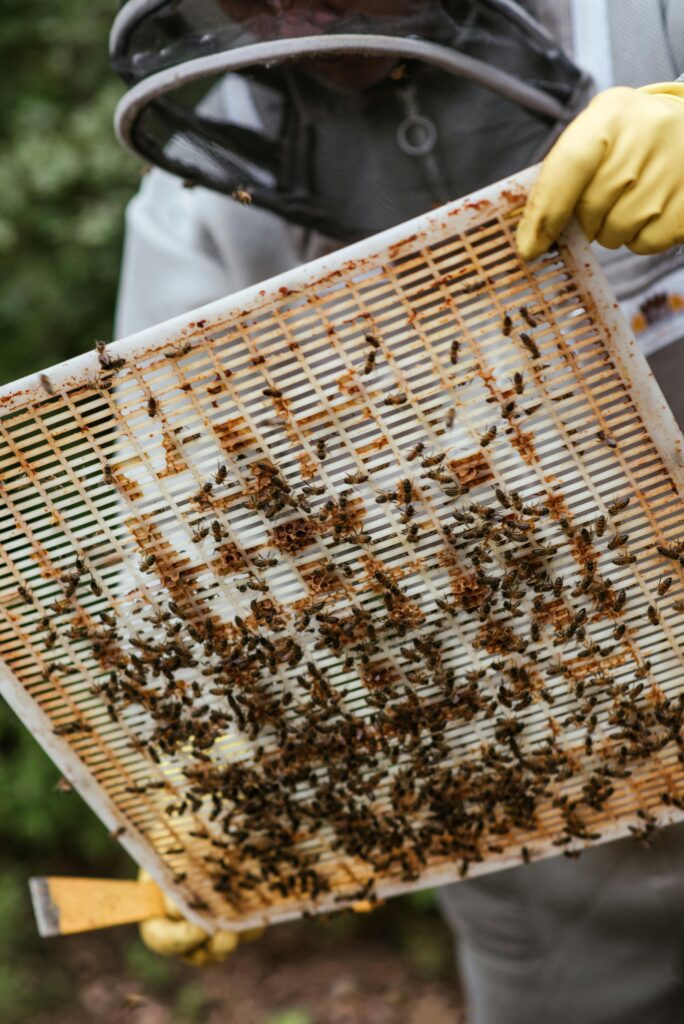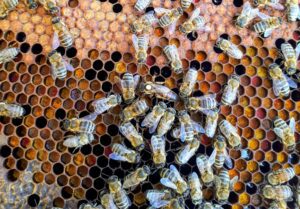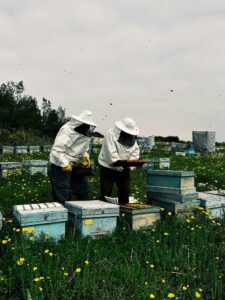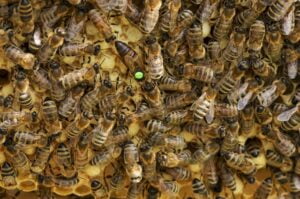In the intricate world of beekeeping, mastering the skill of locating the queen bee during hive inspections is crucial. As the heart of the colony, the queen ensures the hive’s stability and productivity through her egg-laying prowess. However, amidst thousands of industrious worker bees, spotting her can be a challenge. This article delves into essential techniques and strategies that beekeepers can employ to confidently find and identify their queen bee. By understanding her behavior, utilizing specialized tools like queen excluders, and interpreting worker interactions, beekeepers can effectively manage their hives and foster thriving bee populations.

Table of Contents
Tip 1: Begin Locating the Queen in the Brood Nest Area
Focus on Where the Queen is Most Likely to Be
Start your beekeeping inspection in the brood nest area where the queen is most likely to be actively laying eggs. The brood nest is typically located in the center of the hive and consists of frames where eggs, larvae, and capped brood are found. Queens tend to spend a significant amount of time in this area to ensure colony health, reproductive success and growth.
Check Frames with Young Brood First
Young brood frames are a prime location to begin your search for the queen. Queens prefer to lay eggs in cells containing young larvae, so these frames often house the queen during her egg-laying activities. By inspecting these frames first, you increase your chances of quickly locating her before she moves on to other parts of the hive.
Tip 2: Look for a Distinctive Larger Abdomen
Identify the Queen by Her Unique Size and Shape
The queen bee can be identified by her distinctive larger and elongated abdomen, which contrasts sharply with the smaller and more compact abdomens of worker bees. This anatomical difference allows her to perform her crucial role of egg-laying efficiently throughout the hive. Unlike worker bees, whose abdomens are adapted for tasks like nectar collection and hive maintenance, the queen’s elongated abdomen is specialized for her reproductive function.
Drone bees, on the other hand, can be distinguished from both queens and workers by their larger bodies and broader abdomens. Drones are male bees whose primary role is to mate with virgin queens from other colonies. Their broader abdomens are adapted for storing sperm received during mating flights. When inspecting a hive, drone bees are usually larger and stockier than worker bees but smaller and more compact compared to the queen. Their presence in the hive is often seasonal and tied to mating periods, making them less frequently encountered during routine inspections compared to queens and workers.
Compare with Worker Bees for Size Contrast
To confirm the queen’s identity, compare her size directly with nearby worker bees. The stark difference in size will become more apparent with practice, making it easier to differentiate her from the smaller worker bees. This visual comparison is a fundamental skill for beekeepers aiming to confidently identify the queen during hive inspections.
Use a Queen Marking Chart for Reference
For beekeepers who use marking techniques, consulting a queen marking chart is invaluable. These charts categorize queen bees by the color-coded paint dots or numbers applied to their thorax. Each color represents a specific year, allowing beekeepers to track the age and performance of their queens. Referencing a marking chart helps ensure accurate identification and management of queen bees in the hive.
Tip 3: Observe the Bees’ Behavior Around the Queen
Watch for Bees Forming a Circle or Cluster
Worker bees exhibit distinct behaviors when in the presence of their queen. One common behavior is forming a circle or cluster around the queen to protect and attend to her. This circle formation helps regulate the queen’s movements within the hive and ensures her safety amidst the colony’s activities.
Notice Workers Feeding and Grooming the Queen
Workers play a crucial role in caring for the queen bee by feeding her royal jelly and grooming her with their antennae and mandibles. These grooming sessions help maintain the queen’s cleanliness and health, essential for her role in egg-laying and colony cohesion. Observing these caregiving behaviors can lead beekeepers to pinpoint the queen’s location within the hive.
Be Alert for Guard Bees Protecting the Queen
Guard bees are tasked with protecting the queen from any perceived threats or disturbances within the hive. They form a defensive barrier around her, signaling their readiness to defend against intruders. Recognizing the presence of guard bees can guide beekeepers to the queen’s whereabouts, as her safety is paramount to the colony’s survival.
Tip 4: Use a Queen Excluder for Easier Identification

Temporarily Isolate the Queen for Better Visibility
Introducing a queen excluder during hive inspections can simplify the process of identifying the queen bee. A queen excluder is a device placed above the brood chamber that allows worker bees to pass through while restricting the queen’s access. By isolating her in the upper frames, beekeepers gain clearer visibility and reduce the likelihood of disturbing brood or honey storage areas.
Place the Excluder Above the Brood Chamber
Strategically positioning the queen excluder above the brood nest but below any honey supers ensures efficient hive management. This placement prevents the queen from laying eggs in honey storage frames, maintaining honey purity. It also facilitates easier access for inspections without disrupting the colony’s overall brood rearing and honey production activities.
Tip 5: Check for Markings on the Queen Bee

Look for Painted or Numbered Markings
Many beekeepers mark their queens with colored paint dots or numbers on their thorax to aid in identification during hive inspections. These markings are typically applied in a specific color code system according to the year of the queen’s introduction or replacement.
Verify Markings are Clear and Recent
Over time, queen markings can fade or become obscured by propolis and beeswax buildup. It’s essential to verify that the markings on the queen bee are clear, recent, and easily distinguishable. Clear markings facilitate quick and accurate identification during routine inspections and ensure effective management of queen bees within the colony.
Tip 6: Pay Attention to the Queen’s Movement Patterns
Notice the Queen’s Calm and Steady Movements
Unlike worker bees that move quickly and erratically around the hive, the queen bee moves with deliberate and steady movements. Her unhurried pace allows her to inspect cells and lay eggs efficiently throughout the brood frames.
Track Her Movements Across Frames
Tracking the queen’s movements across frames is essential during inspections. She may temporarily move away from the brood nest to explore other areas of the hive. By patiently observing and following her path, beekeepers increase their chances of successfully locating and monitoring the queen bee’s activities.
Tip 7: Utilize a Bee Frame Holder for Better Visibility
Keep Frames Steady and Secure for Easy Inspection
A bee frame holder is a valuable tool that provides stability and security when inspecting hive frames outside of the hive. By securely holding frames in place, beekeepers can conduct thorough inspections without disrupting bees or damaging delicate comb structures.
Use a Hive Tool to Lift and Hold Frames
Using a hive tool to lift and hold frames in the frame holder enhances the inspection process. This technique allows beekeepers to maintain control and maneuverability while examining each frame closely. It also frees up both hands for detailed observations, ensuring comprehensive assessments of hive health and queen presence.
Tip 8: Conduct Inspections in Optimal Weather Conditions
Choose Warm, Calm Days for Hive Inspections
Selecting warm and calm days for hive inspections promotes favorable conditions for bee activity and colony stability. Bees are more active and less defensive during sunny weather, facilitating smoother inspections without undue disturbance.
Avoid Rain or Strong Winds
Inspecting hives during adverse weather conditions like rain or strong winds can agitate bees and disrupt their normal behaviors. These conditions also pose challenges for beekeepers trying to maintain control and safety during inspections. Waiting for suitable weather ensures both beekeeper and colony safety during hive assessments.
Tip 9: Practice Patience and Take Your Time
Avoid Rushing and Carefully Examine Each Frame
Patience is key during hive inspections to carefully examine each frame and observe bee behaviors. Rushing increases the likelihood of missing important details or overlooking the queen’s presence.
Repeat Inspections if Necessary
If the queen is not immediately found during an inspection, repeat the process systematically. Sometimes, the queen may move or hide within the hive, requiring thorough and persistent efforts to locate her. Repeat inspections ensure comprehensive assessments of hive health and queen status.
Tip 10: Seek Assistance from Experienced Beekeepers
Learn from Experts and Join Beekeeping Communities
Engaging with experienced beekeepers provides valuable insights and guidance for improving queen identification skills and overall hive management. Joining beekeeping communities or attending workshops fosters knowledge sharing and mentorship opportunities.
Attend Workshops and Training Sessions
Participating in beekeeping workshops and training sessions offers hands-on learning experiences and practical skills development. These sessions cover advanced techniques for queen finding, hive maintenance, and disease prevention, enhancing beekeeping proficiency and colony success.
Additional Resources
Beginner Beekeeping Kit – 6 Essential Tips Beekeepers Should Know Before Buying
Beginner’s Guide to Beekeeping: 8 Steps for Starting Your Journey
Being Serious about Saving Bees from the USDA
Conclusion
Successfully locating the queen bee is not just about identifying a single bee; it’s about understanding the dynamics of the entire colony. By honing skills in queen identification and observing her interactions within the hive, beekeepers can enhance their ability to maintain colony health and productivity. Tools such as queen excluders and careful inspection techniques play crucial roles in this process. With patience, practice, and a deep understanding of bee behavior, beekeepers can ensure their colonies thrive under the leadership of a healthy and productive queen.



